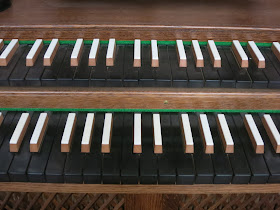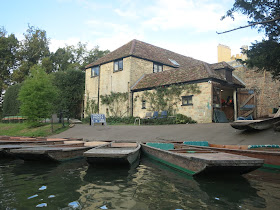If you plan to visit a university in England, that's usually a toss-up between the University of Oxford (established in 1096) and University of Cambridge (established in 1209). Both are in the list of world's top 5 oldest universities. Well and good if you can visit both but since we didn't have the luxury, we ended up picking the University of Cambridge.
Who are the most popular alumni of the University of Cambridge? Sir Isaac Newton, Charles Darwin, Charles Babbage (the inventor of the first computer), William Fox Talbot (inventor of the camera), Stephen Hawking and other mathematicians, inventors, scientists, politicians, world leaders, religious leaders, literary geniuses, etc.
Its former undergrads have won a total of 61 Nobel Prizes to date. That's the most number of Nobel Prize wins for any university. Wow.
Sharing with you my top 5 tips if you plan to visit the University of Cambridge:
1. How to get to the University of Cambridge. From King's Cross Station or Liverpool station, you can take the National Rail. Get off the Cambridge Station. Then take bus 1 or 7.
2. Know which college buildings you want to visit beforehand. Cambridge University is huge. If you're going there, you have to know which specific college buildings you want to visit because when you get off the Cambridge station, you can't ask people "How do I get to the University of Cambridge?" coz there are 31 constituent colleges in Cambridge! :)
We ended up visiting King's College. It was founded in 1441 by King Henry VI.
 |
| King's College Chapel |
 |
| King's College Chapel |
 |
| Pipe Organ at the St John's College chapel |
King's College Chapel is famous for its College Choir. Since it was established in 1441, King Henry VI provided 16 choir members and 10 chaplains to sing daily services in the Chapel.
Today, King's College still has 16 choir members and all members are educated at the King's College. The choir is world-renowned. Each Christmas Eve, the King's College Choir performs The Festival of Nine Lessons and Carols and it is aired by BBC radio and syndicated to hundreds of other radio stations outside of England.
 |
| Intricate ceiling details |
 |
| Beautiful stained glass windows |
Ever wondered how these beautiful stained glass windows are produced?
Here's how in pictures -
 |
| The making of the "Death of Ananias" stained glass window |
And here's the final product - I had to look for it in the King's College Chapel windows. :)
 |
| Antique keyhole. |
 |
| Closet made from oak which is believed to date back from1480. |
 |
| Beautiful interiors of the King's College Chapel |
 |
| White sharp keys against black keys. Disorienting....Haha... |
 |
| King's College |
 |
| Proof that I've stepped on the grounds of King's College. Haha... |
3. Catch the world-renowned King's College Chapel Choir sing. They sing every 5:30pm on Mondays to Saturdays (though there are days when there is none so better to reconfirm with the front guard). People start lining up at 5pm. We actually lined up already but I asked the guard if we can leave mid-way the evensong since we had to catch a train ride but he said that it's discouraged since the ceremony is solemn. So too bad, we weren't able to hear them sing. :(
4. Join a tour. When I googled for information, I read that there are regular tours around the university but we miscalculated the travel time and missed the last tour for the day when we arrived. I also wasn't able to research about free walking tours so we ended up joining a Punt Tour.
But I always prefer Walking Tours over Canal Tours coz it's more slow-paced which means there's more room for interactivity between the guide and participants plus there's more time to take photos. Haha... Here's a free walking tour I found online - but just make further research to check if the reviews are good - http://www.footprints-tours.com/cambridge-walking-tours/tours/2-hour-free-cambridge-walking-tour/)
 |
| Punts for rent |
 |
| Guided tours by the punt |
 |
| View of King's College Chapel and King's College by the canal |
The advantage of doing a punt tour is you're able to visit most of the colleges in maybe 45 minutes to 1 hour including walk time to the punt station. The disadvantage? The pace of the tour is so fast (versus walking), thus, you could barely retain any information during the tour. It's also hard to listen and difficult to take photos. :( Here are some of the photos I took but sadly, I can't recall what colleges or buildings they are. :(
The only building I could recognize is the Trinity College for 2 reasons - (1) this is the college of Sir Isaac Newton and the guide said that the falling apple happened right here at the school grounds and (2) the guide said that Trinity College was shortlisted before as a possible location for Hogwarts (that caught my attention coz I'm an HP fan. Haha...)
 |
| Trinity College |
 |
| Wall of the Trinity College |
During the canal tour, you'll pass by a lot of bridges along the way -
 |
| Cambridge version of the Bridge of Sighs |
The most popular one is called the Mathematical Bridge - sounds so intellectual! I'll explain shortly why it's called such.
 |
| Mathematical Bridge was rebuilt on 2 occasions - 1866 and 1905 |
The bridge appears to be an arch, right? But guess what? It is composed of entirely straight timbers!
 |
| Under the Mathematical Bridge |
So why is it called the Mathematical Bridge? Here's the verbatim explanation on wikipedia (it's beyond my comprehension though! Haha...):
The arrangement of timbers is a series of tangents that describe the arc of the bridge, with radial members to tie the tangents together and triangulate the structure, making it rigid and self-supporting. This type of structure, technically tangent and radial trussing, is an efficient structural use of timber, and was also used for the timber supporting arches used for building stone bridges. Analysis of the design shows that the tangent members are almost entirely under compression, while the radial timbers are almost entirely subject to tension with very little bending stress, or to put it another way, the tangent and radial elements elegantly express the forces involved in arched construction.
If you didn't understand any of the text above (like me! haha...), here's the easiest way to understand why it's called the Mathematical Bridge. Remember I said the bridge is made entirely of straight timbers? The straight timbers were arranged in an unusually sophisticated engineering design that the bridge appears to be an arch.
For some visual reference, here's a photo from Wikipedia which highlights the straight timbers specifically referred as the tangential members of the tangent and radial trussing in the complicated explanation above. After seeing the photo below, that was the only time I got the essence of the explanation. Hahaha....
During the canal tour, we also spotted some modern structures which look like residential structures -
After the punt tour, we were still able to explore by foot on our own. There are also tourism offices where you can inquire what other interesting activities you can still join for the day depending on your interests.
 |
| Posters of various events are tied to fences. These events are part of the university social life. |
 |
| Lots of stores and cafes line up the streets. |
 |
| Cambridge University Sculpture Map |
5. Be conscious of time. It's so easy to forget time when you're in Cambridge but you can't afford to forget when you're on a day trip because you might miss your train ride going back to London. Travel time one-way is between 2 to 3 hours including the bus ride and switching trains. So if you think one day is not enough, you might have to plan an overnight stay in Cambridge. :)


















